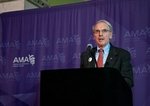Government
Ending abortion conscience rule?
■ The regulation, which has split the medical community since its enactment, has many fearing it could endanger funding for and access to care.
By Amy Lynn Sorrel — Posted March 23, 2009
- WITH THIS STORY:
- » Path to rescission
- » Related content
The Obama administration in March started the process of rescinding a controversial rule from President Bush that reinforced protections for physicians and other health care workers who object to providing abortion-related services based on their personal beliefs.
The move comes just two months after an 11th-hour Bush administration conscience regulation took effect.
Obama officials at the Dept. of Health and Human Services are proposing to "rescind in its entirety" the Bush rule, which built on existing federal laws authorizing HHS to withhold or revoke federal funds from recipients found coercing or discriminating against doctors who exercise their conscience rights. The provisions require qualifying health care entities, including some physicians, to certify compliance in writing by Oct. 1. The rule also authorizes the HHS Office for Civil Rights to investigate discrimination complaints.
The rule, first proposed last August, stoked a firestorm of opposition from state and federal authorities and the medical community, including the American Medical Association and the American College of Obstetricians and Gynecologists. Many physicians feared that the mandate exceeded existing protections and could endanger both funding for and access to care.
Such comments "raised a number of questions that warrant further careful consideration," HHS stated in its newest proposal, released March 10. A 30-day comment period is open until April 9, after which the final rescission process could take several additional months as officials sort through the comments. If pursued, a replacement regulation would entail a new rule-making process that would take additional months to complete.
HHS requested that commenters provide specific information on whether the final rule:
- Reduces access to information and health care services, particularly for low-income women.
- Provides sufficient clarity to minimize potential harms resulting from any confusion over the requirements.
- Could be accomplished through nonregulatory means, such as education and outreach.
The AMA and ACOG stood among dozens of medical organizations that had urged the Bush administration to withdraw its conscience rule before it was finalized. At AMNews press time in mid-March, both organizations were drafting comments in response to the new rescission proposal.
Many physicians and abortion-rights advocates worry that vague provisions in the rule could be construed to give a wider range of health care workers the right to deny contraception services and abortion-related referrals or information.
"Refusal already has a disproportionate impact" on access to care, said Gretchen Borchelt, senior counsel for the National Women's Law Center, which supports abortion rights. "This [rule] opens the door further and only creates confusion over how it interacts with existing state and federal laws." Doctors and others already have legal recourse through various anti-discrimination laws, she added.
Certification requirements also pose a burden for individual doctors, the AMA and other physician organizations warned in a September 2008 comment letter.
Seven states sued to block the rule for fear it would trump state laws guaranteeing access to a variety of abortion-related services. Connecticut Attorney General Richard Blumenthal, who led the multistate lawsuit, said legal action will continue until the rule is finally revoked.
Revise instead?
But some physicians and anti-abortion groups say the rule is a necessary protection and plan to ask HHS officials to clarify the language rather than void it.
Christian Medical Assn. CEO David Stevens, MD, said the rule simply provides an enforcement mechanism for existing protections. In releasing the final rule, HHS officials under Bush also expressed a need to deter discriminatory practices.
"Once you take any consequences away, the laws become meaningless," Dr. Stevens said. "Ultimately, it just forces doctors with conscience issues out of practice."
Congress already found it necessary to protect physicians' conscience rights when it enacted the federal laws that are now on the books, and HHS has an obligation to enforce those safeguards, said Denise M. Burke, Americans United for Life vice president of legal affairs. Both organizations plan to submit comments.
"You don't have to violate someone's conscience to access health care. You simply go to another provider," Burke said. "If [opponents] are concerned the rule isn't clear enough, the proper remedy is not to rescind the rule, but to clarify it."
 Subscribe to Email Alert
Subscribe to Email Alert








